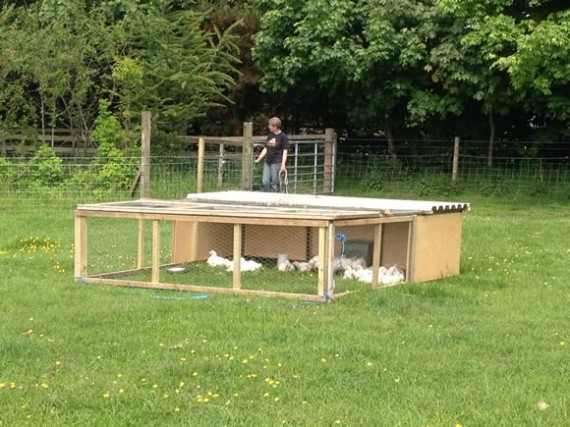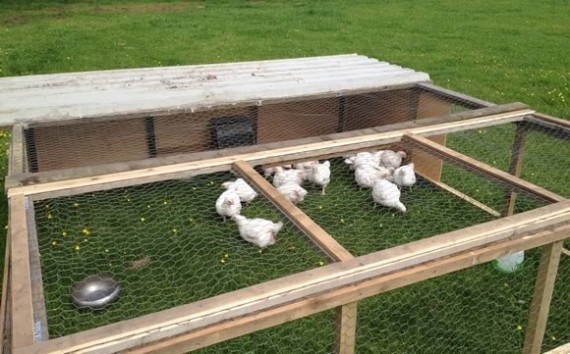Posted: Sunday 30 June, 2013
We’ve raised a couple of batches of meat chickens every year for a few years now.
We usually buy two batches of 10 or 12 birds, one in April and one in August. This pretty much keeps us in poultry meat – actually, it DOES keep us in poultry meat because we don’t buy it elsewhere.
Until this year, the birds have been Hubbards, reared under a light for 3-4 weeks and then in a smallish pen that we move every day or so until it’s too small and then we give them a biggish temporary pen until they are slaughtered at 12-14 weeks. We fed chick crumbs until 6 weeks then grower pellets until they are ready to go, weighing 5-7lb oven ready weight.
Last year, we allowed the second batch to free range in the vegetable garden – an exercise not to be repeated because of the destruction wreaked – but they sure ate a lot fewer pellets and they weren’t any smaller when they went to the big henhouse in the sky.
Earlier this year, Dan read a book called “The Omnivore’s Dilemma; The Search for a Perfect Meal in a Fast Food World” by Michael Pollan. Pollan worked for a while at Polyface Farm and his description of the pasture raised poultry interested Dan, so he’s done some further research – he’s now reading Joel Salatin’s, of Polyface Farm, book “Pastured Poultry Profits”. This has changed how we are raising our meat chickens this year and probably forever.
This year we have one batch of 20 Ross Cobbs, now five weeks old. They have been off heat for more than two weeks now and have just gone on to grower pellets (for no other reason that the chick crumbs are finished and I’m not buying any more). They are also the pilot for our pasture reared poultry.
The idea is that the birds are kept in a pen at pasture and the pen is moved the length if itself every day (or twice a day when the birds are big). This is good for the birds – fresh grass, bugs, fresh air and exercise – but it’s also good for the pasture because the birds fertilise it, break down any dung from cattle or sheep that have grazed the pasture previously and eat any parasites in the dung and on the pasture. They also eat less of the increasingly expensive bought-in feed.
 Pasture poultry pen.
Pasture poultry pen.
John build the pen from wood and wire that we already had around the place, but even if you had to buy the materials, it wouldn’t be expensive. We used our existing brooder box until the chicks came off heat. It’s too early to talk about cost of feed – Salatin reckons that intake of bagged feed drops by about 30% but that growth rates are maintained. We also don’t know what the impact on the grass will be but poultry poo is high in nitrogen so we’ll probably have a bright green strip in the field – perfect for cattle, not so good for sheep or ponies.
 Poultry pen close-up.
Poultry pen close-up.
Dan’s quite keen to pursue this further and expand the enterprise to sell to the public but we need to work out costs first – it may be that production costs mean that the sale price we have to put on the poultry meat is prohibitively high – and if we are going to pursue it as an income generating enterprise, we will also have to address the issues of killing, processing and waste disposal.
And marketing. These won’t be budget birds; neither will they be certified organic.
So it’s early days but today, we had very happy chooks, eating grass, scratching around and being, well, chooks, so if we only continue to produce for ourselves, we’ll be very happy with the welfare standards.
- Previous « Protecting apple trees from poultry
- Next A sheepy week »
Comments
Rosemary
Hi Neil
Ross Cobbs were what we could get at the time we wanted them. Too early to tell if there is any difference between the two, although the Hubbards are bred for outdoors and the RC for indoors, I believe.
farmers wife
Be interested in hearing your feedback on Joel Salatin's system. We have read all his books (&DVDs) and interested in his ways of low input farming. Have you made a cost saving - labour & feeds? What have been the highs and lows?
Rosemary
I *think* they are less but couldn't guarantee it. The best bit was not having to muck out :-) You could only do it in the summer though; and we have flatt fileds which makes moving the cage easy. If it was hilly, it would be a nightmare.
Comments are now closed for this post.












Neil
Tuesday 2 July, 2013 at 12:09pm
Any reason behind the change from Hubbards to Ross Cobbs? Are they better for this type of less intensive system?